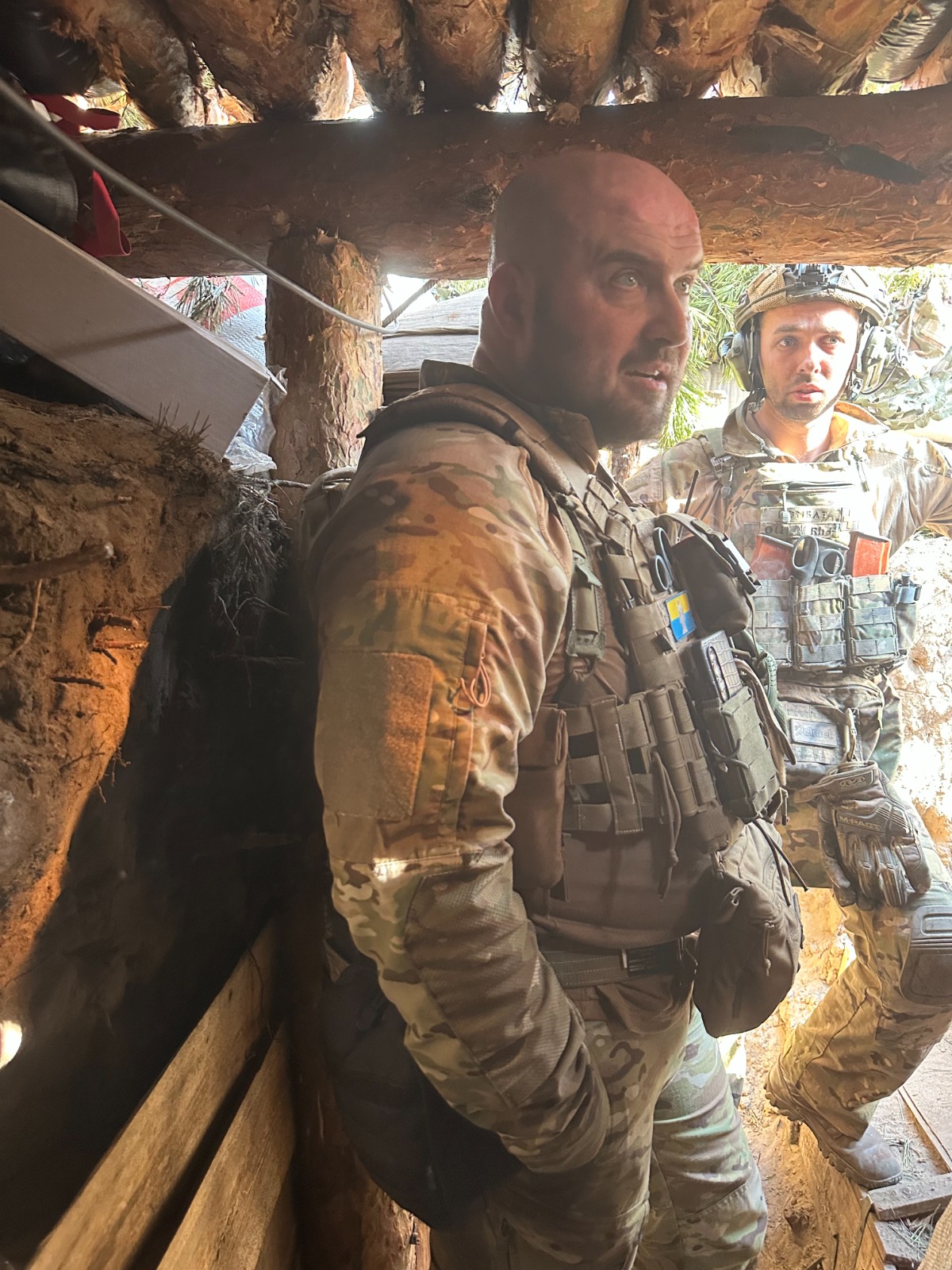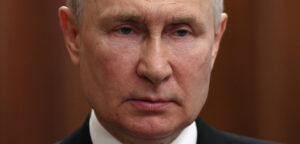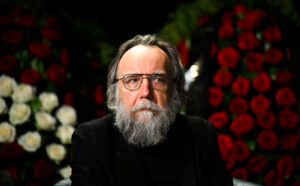I’m running. Shells explode around me. Sometimes they roar like thunder; sometimes they whistle on approach. Large parts of the forest are on fire. Smoke rolls by like dry ice.
“Run. Run. Run,” says Dima. I follow him over the fallen trunks of trees felled by artillery; over shell craters that have become pools; through the deep grooves of old vehicle tracks. I’m slowing down now. My ill-fitting helmet is slick with sweat. Droplets sting my eyes.
“Don’t touch anything!” shouts Dima as he turns to motion to a wooden box lying on the earth. It could be mined. We are in the “Forest of Surprises” on the front lines of Kreminna, running to the Ukrainian trenches near the zero-contact line. There, Ukrainians and Russians are killing each other just metres apart.
Up in the sky, Mavic drones are scouting for movement. In the distance are three lines of Russian brigades. All I see is Dima just ahead of me, a commander in the Dnipro 1 Battalion, zig-zagging through lethal hail to deliver a drone to his comrades. Strip it all away: the tech and the money; the politics and the endless tweeting. This is what war comes down to: men running through forests praying that the shells won’t hit them.
***
“We are proud that Dnipro 1 was the first volunteer battalion to form in 2014 to fight the Russians.” It’s earlier that day, and over a year since I last saw battalion commander Yuriy Bereza, one-time politician and full-time warrior. His beard has grown since I embedded with his unit in Rubizhne on the eastern front. It hangs from his chin like a Kung-Fu master’s; he even caresses it in that slow, pensive way. “I’m not cutting it until we win,” he says with a smile.
Sitting on the P66 highway that reaches across the border into Russia, Kreminna was one of the first places the Russians targeted last February. The city’s mayor, Volodymyr Struk, who was reportedly in their pay, was found shot in the heart in early March. “Unknown patriots,” was Kyiv’s terse explanation. But they could not stop the Russians taking the city in April. They have held it ever since.
When the Ukrainians pushed the enemy out of the nearby town of Lyman on 1 October, Kreminna became integral to sustaining Moscow’s invasion. “The Russians understand that if they lose Kreminna, their entire line of defence will fall,” said Luhansk’s Regional Governor. They have, accordingly, built up significant fortifications in the city and the surrounding forests. The Kremlin has also sent in troops from around Kharkiv and the northern theatre to bolster their line of defence. Re-taking the city is now vital to Kyiv’s counter-offensive.
Dima’s battalion is stationed in a building that, until recently, was occupied by Russians. “That wasn’t us,” he says sheepishly, pointing to a mound of rubbish left outside. “It was the Russians — we haven’t had a chance to clear it up yet.” In a place where assault rifles loll against walls, his embarrassment strikes me as incongruous and oddly sweet — a leftover refinement from before the world went mad.
In his HQ, Bereza sits drinking coffee. “We met in April, right?” I nod. “Well, since then, the battalion has been involved in many battles. Kharkiv, Leman, Izyeum, Kopiansk, Kreminna. All the difficult fighting.”
A couple of days earlier, I spoke to Dima over the phone. “It was hard today,” he told me. “Russians were attacking with everything — artillery, drones, tanks, planes. We got to a clearing in the forest and then suddenly I saw 100 of them charging towards us… Fuck man… That was hard.” More than 90% of the soldiers in Dnipro 1 have been injured once; more than 70% twice; almost 50% three times. Since March, 22 of his 600 comrades have been killed.

I ask Bereza about the situation on the front. He sighs. “The main problem since we last met is that we still haven’t received anything from the lend-lease list [an agreement in which the US agreed to supply material, including weapons, to Ukraine]. We have only old cars and Soviet weapons. We don’t even need powerful weapons — just mortars and artillery. Get those and we can liberate Kreminna in two weeks. Officially, we are promised lots of things, including Bradleys and Brownings. Practically, we don’t see anything — and we are in the most intense places with the most intense fighting.”
As an explosion pierces the air, Dima interrupts. “This is the way it works. First, lend-lease [equipment] goes to Special Forces. Second, to the airborne brigades. Third, to operative units of the National Guard. Then, if something is left over, it comes to us. But it never does. There are a lot of weapons in the country — we know which units have them. But the way the general staff share them is not the best. Sometimes weapons are given to troops who are not prepared. It’s the result of bad decision-making.” Bereza goes on to explain that many Western weapons are not on the front line because they are deployed according to the agreement negotiated in March 2022. A lot has changed since then. “It’s stupid,” he says.
The following day, I saw their frustration simmer over when, in the middle of a conversation with Dima, Bereza got a call. “Don’t fucking give me excuses! Don’t tell me what the situation is here. I am here — I tell you what the situation is!” he bellowed into his phone. “We are fighting intensely, and you don’t give us machine guns or snipers? Every day we let the Russians escape. Why can’t we put machine guns in position? Why do I have to wait days for this shit? Where are my fucking weapons?”
Now, though, Dima is clear: “The situation on the front is totally different from on paper — from what middle-management officers think. We need to be able to change orders based on a changing reality. If a soldier fights, he risks death. But the people who fight in the paper army carry no risk. It’s just another day. We need to change this. They are writing while we are dying.”
A message pings on Bereza’s phone. He grins. The air force is using UK-supplied Storm Shadow missiles, he tells me.
But will that be enough for the counteroffensive to succeed? They both grimace. “Not only do we not have enough weapons, but the Russians have completely mined the front,” Bereza replies. “They also have a lot of brigades on their second and third lines. So we must first destroy those, for which we need more long-range missiles, and only then think about breaking through.”
Dima weighs in: “We are very grateful for Western weapons. But sometimes Western countries and politicians think they can give us 20 bullets and a piece of Ukrainian territory will be liberated. These are arguments made from maths and physics — but for the counter-offensive to be successful, you have to kill a specific amount of Russian troops to break through. This is the equation. Not the amount of bullets, but the amount of dead Russians.
“Also — and we don’t like to admit it, but I will — the quality of the new soldiers is getting worse. Before it was just volunteers, now it’s conscripts and they’re not so motivated. Before, when we lost comms with the troops, we knew they wouldn’t abandon the positions. But now we need to coordinate every step — speaking constantly to the sergeants to micro-manage everything.”
There is a broader political dimension to all this. Western countries have supplied weapons to Ukraine on the understanding that they will make significant gains against the enemy. For the first time, Ukrainian comms have let Kyiv down. Many in London and Brussels and Washington appear to believe that the counter-offensive means thousands of Ukrainians charging the Russian lines and breaking through — but here on the front, it just doesn’t work like that. “The counteroffensive is military dancing,” Bereza concludes. “We move our troops from point to point to make them think we will break through in that exact place. And when they move, we destroy them, draining their reserves. It could last for months without a breakthrough. It’s not a miracle.”
Another explosion sounds. “Ooh, an Excalibur,” says Bereza excitedly.
***
“Ok, then, if you haven’t changed your mind, you can come to the zero-contact line. But David, please understand it’s very dangerous.” It’s lunchtime and we are sitting in the base’s kitchen. Bereza is fastidiously cutting courgettes into small slices in preparation for dinner. I am offered a bowl of small raw cloves of garlic to munch on.
Dima needs to deliver a drone to the battalion’s trench on the zero-contact line — and is letting me accompany him. I shouldn’t really be going, and Dima is clearly nervous about the trip. “David, you won’t wear that on the front, will you?” he asks, pointing to my white T-shirt. I assure him I have packed something far less incongruous.
Half an hour later, as we are getting ready, he rips the Velcro “Press” sign off my body armour. The Russians, he explains, want to kill journalists. It will make me more of a target. We get in the 4×4 and start to drive.
Dima asks me if I’ve had first aid training. Can I use a tourniquet? Give CPR? There are only two of us; he needs to know that I’ll be able to do something if he gets hit. As we approach the front, the road disappears and Dima stops to put the tires on four-wheel-drive mode. “In war you need to be a good driver,” he says. “Because if you’re not a good driver, you’re dead.” Dima has messaged ahead to the trench that we are almost there. We pass two bullet-ridden vehicles by the side of the road. “That’s war,” he says, before turning up the music on his phone. Creedence Clearwater Revival are belting out “Fortunate Son”. “Fucking Vietnam!” roars Dima with delight. “We need a fucking helicopter!”
As we enter the Forest of Surprises, the sun disappears behind trees and the sound of shelling begins. The “surprises” here include tanks, mines, drones and artillery, to name a few. Dima explains that we are now so close to the Russian positions that the combat is almost face-to-face. The scenery around us transforms into flames. Smoke clogs the air, squeezing out the oxygen; the ground is a veil of ash. Small fires rage everywhere. “Look what the fucking Russians have done to my country,” says Dima. “If they cannot take the country, they will destroy everything in it.”
The vehicle bounces around, weaving in and out of felled trees and shell craters, which we need to do anyway for security: set a straight course and a drone might be able to calculate our trajectory and call in a strike. In this sense at least, the smoke is good because it gives us cover from the enemy overhead.
As we approach the front, Dima begins to focus on the hard end of his job. “Our commander says that out here we have two missions,” he adds. “The first is: don’t die. The second is: kill Russians. We especially need to observe the first, because if you die, you can’t kill Russians,” he says with a smile.
The shelling is louder now. Dima points out the different effects of different kinds of weaponry. Artillery fells trees at the base. Rockets obliterate them. This war is becoming an ecological catastrophe almost as much as a human one. Ukrainian soldiers appear. They are walking in single file along the side of the path, moving between positions or simply rotating out. We are now officially right on the front. We park up and get out. Dima puts the boxed-up drone under his arm and tells me to follow him all the way — staying close. We run through the front as shells go off around us. Eventually, we reach a small clearing and there, beneath a canopy of branches acting as camouflage, three small steps lead down into the earth.
This is the trench by the zero-contact line. I scuttle down as a shell explodes. Inside are six men packed into a space of about 7×7 feet. A radio sounds in the background. Dima hands over the drone and chats to the guys. The rotation here is three days on the front, six days back at base. I ask one of the soldiers, Olek, what his role is. “Nowadays, I try to kill Russians,” he replies.
As we wait for the shelling to subside, I am handed some Indian tonic water caked in sand. The guys start to laugh at my helmet. Back in Odesa, I managed to source only an olive green one, which made me look like a soldier, so I was also handed a black cover to cover it. But according to the soldiers here, I look more like a priest. I sheepishly take it off.
When it’s time to leave, we scramble out of the trench to the sound of buzzing. “Faster, faster, faster!” yells Dima. A small, black Ukrainian drone whirrs past, making its way through the trees toward the Russian positions. As we draw closer to the car, I slow down to look at the sun shining through the trees: it’s strangely beautiful. Suddenly a shell explodes off to the right. Dima gesticulates furiously at me to hurry. The Forest of Surprises is no place for sightseeing.
***
The following morning at the base, after our successful mission, Bereza presents me with a signed Battalion flag. My fixer Rodion is impressed. “This is a huge honour, David,” he tells me. “The flag [of a battalion] is very sacred. It says: ‘We respect you, we trust you — you are one of us.’”
I’m not one of them, though. I’m just an observer. I dashed only once through the front under fire with Dima. These men do it almost every day. Are they heroes? I remember something Dima told me the day before, as we were discussing the problem with weapons and central command.
“They say we are an army of heroes,” he told me. “But we don’t need heroes. We need soldiers who live. Heroism is complete fucking bullshit. You only create heroes when someone somewhere has made a mistake. At the heart of every heroic story is a human life. A mother without a son. A daughter without a father. A country without its citizens. Let’s have no more fucking heroes.”
Disclaimer
Some of the posts we share are controversial and we do not necessarily agree with them in the whole extend. Sometimes we agree with the content or part of it but we do not agree with the narration or language. Nevertheless we find them somehow interesting, valuable and/or informative or we share them, because we strongly believe in freedom of speech, free press and journalism. We strongly encourage you to have a critical approach to all the content, do your own research and analysis to build your own opinion.
We would be glad to have your feedback.
Source: UnHerd Read the original article here: https://unherd.com/



